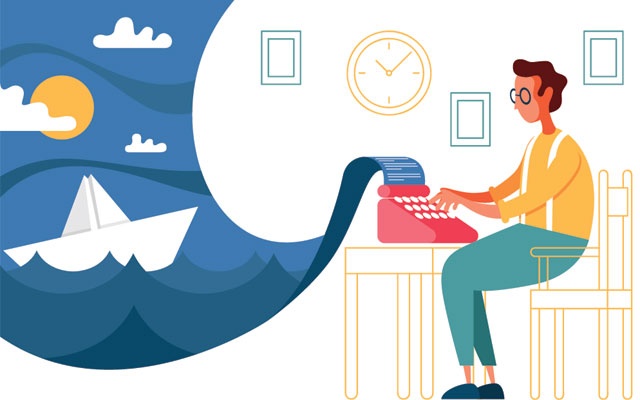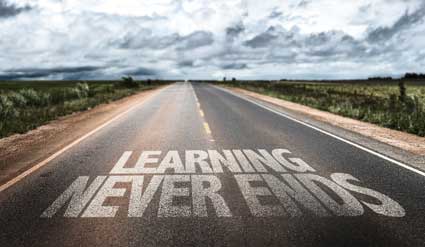The goal of advertising is to sell products and services. Your job as a copywriter is to use words to sell those products and services. It's a guarantee that it will be unlike any writing you've ever done before. Perhaps if you've written articles or worked as a journalist, you know how to write clearly and concisely. You know how to write to get the facts across and inform your readers. However, to be a copywriter, you have to learn to write to persuade your readers to buy a product. It's a whole new world.
Features Versus Benefits
Whenever you write ad copy, you want to sell the benefits, not the features. You want to use those benefits as selling points to tell readers what the product can do for them. That said, it can be difficult to distinguish features from benefits, especially when you're first getting started.
A feature is what something is, such as shape, specs, etc. A benefit is what something does.
Let's look at some examples when talking about a yogurt.
|
Feature |
Benefit |
|
Yogurt is nutritious. |
Yogurt is healthier for you than other snacks – and just as filling. |
|
Yogurt comes in many flavors. |
With over 20 flavors to choose from, you're sure to find one that you love. |
|
Yogurt is low in fat. |
Eating yogurt as a snack won't add inches to your waist. Paired with healthy diet and exercise, it can help you shed pounds. |
|
Yogurt isn't expensive to buy. |
Finally! Something that's good for you that your budget can afford. |
Take note that the features tell what the yogurt is. It's nutritious, low in fat, affordable, and offers a variety of flavors. The benefits tell the reader what the yogurt can do for them. Always sell the benefits in your copy. Benefits are what persuade people to buy.
Structuring Copy to Sell
Different copywriters use different structures when writing copy.
Now, we're going to take a different view. Let's talk about the sequence you should use that has been proven to motivate people to respond to advertisements.
The first thing you should do in any piece of copy is to grab attention. You do this with the headline and any visuals. Your first job is to get them to read the ad, and you do this by using the headline and visuals to grab attention.
Next, state the problem your readers face that your product solves. Show the reader why he/she needs the product. For example, a lot of people don't think they need to join a motor club if they have roadside coverage on their car insurance. If you're selling motor club memberships, you want to make them realize their need for the membership. "I was shocked when I broke down on the side of the road last year and had to have a tow. That tow cost me 500 bucks I didn't have! I thought my insurance company's roadside coverage would cover me, no worries – after all, the policy said it would. But when I looked at the fine print, it only agreed to reimburse me. Within 30 days!"
Once you've showed their need, show how your product fixes their problems. "With XYZ Motor Club, I get 100 miles of towing if I need it – FREE. No out of pocket expense once my membership is paid, no long waits for reimbursements (remember, it's free), and no more worrying about breakdowns on road trips. If I need them, they're there. And they'll even change a flat tire or jump start my battery…"
Next, prove your product will do what you say by talking about selling points (benefits), guarantees, studies – and you can even use testimonials from other happy customers.
Finally, ask for the sale by writing the call to action. Tell them exactly what you want them to do next. "Click the button below to sign up now." Be very specific in your call to action.
If possible, offer them incentive for taking action right away. "Sign up now and receive an additional 10% off your order." Or "Order yours today and get a coupon for 20% off your next order."
Spinning the Truth
You never want to lie. In fact, you cannot lie when writing copy. If you do, you can find yourself in hot water with your client, consumer lawyers, and even the FTC. This means you cannot make false claims. Everything you put into your copy must be true about the product. Every claim you make in your copy must be able to be backed up with fact. Remember this. It's important.
That said, sometimes the truth isn't very powerful. Sometimes the truth will not help to persuade readers and not generate many sales.
Here's an example. Let's say you run a dropshipping company. A customer orders from you, then you order their product from the dropshipping company, who then ships it to your customer. You know that one problem your customers face with your competitors is long shipping times, because your competitors use dropshipping companies that seem to always be sold out of the most popular products.
You know for a fact that the dropshipping company you use rarely runs out of stock. What's more, they ship the orders the same day so that the customer always has their order within three to five days. You know this based on five years of doing business with the dropshipper. It's why you use them.
That said, you could write something like this in your ad:
It is the truth. Even though the customer is going to assume you are shipping from your stock, not a dropshipper's, it is the truth.
Here's another example.
This could be a headline for a tax preparation service. This service keeps track of your expenses and taxes-owed-to-date because you send all your receipts and income information to them all year long – for a low monthly expense. When it's income tax season, they request all final documentation from you, then prepare your tax forms. All you do is review them before the service files them with the IRS. While it's true that you'll never have to pay someone else to do your taxes again, you are going to pay them instead.
Whatever you put into your copy has to be the truth. However, that doesn't mean you can't make the truth more exciting so that it becomes a selling point.
The USP
USP stands for Unique Selling Proposition. A USP is a factor that makes a product or service stand out from its competition. Think of M&M® candies. Their USP is "Melts in your mouth, not in your hand".
This factor is what makes M&M® candies stand out from their competition. All other chocolate candies will melt in your hand. M&M® candies will not.
A company's USP is typically used as their slogan. That makes sense, because it's what makes them unique. It's what makes them different, perhaps better, than the competition. When you use a USP as a slogan, it's just one line. You want it to be as brief as possible, because that way you achieve maximum impact and grab attention.
If M&M® candies used the slogan, "Our candy doesn't melt in your hands like other chocolates. It melts in your mouth" it wouldn't have been nearly as catchy or powerful.
We discussed the importance of using benefits in headlines when you're writing advertisements. The benefit you want to use is the USP. It's what makes the product or service you're selling better than the competition, because your product is offering the consumer something that no other product offers.
Most clients who you work with will be able to tell you their USP. Simply ask them the most important benefit of their product that their competitors don't offer. If it's a new product or, for some reason, they don't know, you will have to find and develop their USP by researching the competition and comparing their products with your client's.
Even if you're not going to use the USP as a slogan, still pare it down to one line. Remember, it makes it more powerful. When you make the USP powerful, it will make it easier to convey that in your headline and the rest of your copy.
What Makes People Buy
What makes people buy one product over another? Why do they choose one brand instead of the other? Is it price? Benefits? An impressive guarantee? Do you know?
The answer is all of those things. All those things help influence the buying decision. However, you can write an advertisement for a product with the best benefits, the lowest price, and no guarantee – and still not manage to sell one single item.
Why is that?
In order to sell a product to consumers, you have to make the product appeal to them. You must convince them they need your product. But how do you do that?
Take a look at the example ad below.
How does this ad appeal to customers? It appeals to their need to look younger and feel more beautiful.
How does it accomplish this?
It appeals to their emotional side.
There's long been a debate over if people buy for logical or emotional reasons. Seasoned marketers and copywriters know that the majority of people buy for emotional reasons. If you can successfully appeal to someone's emotional side, they are more likely to buy.
This is because logic can be overcome with more logic. Let's say you're selling this new and expensive brand of toothpaste. It whitens teeth, prevents gum disease, freshens breath, removes plaque, etc. You write copy that factually tells them how great this toothpaste it. Remember, if you're appealing to your consumers' logical side, you will present facts. Facts make a purchase logical.
Now let's say a consumer reads your ad and realizes they need good toothpaste. Your toothpaste has excellent reviews. Your ad is strong. They want your toothpaste. They need your toothpaste, and they know it's logical to buy it since it's what they need. It's all about logic, right?
But since you're appealing to their logical side, they're also thinking about their current toothpaste. It does a good job. The last visit to the dentist for a cleaning was easy peasy – they were only in the chair a minimal amount of the time, and the dentist praised their dental hygiene habits. Plus, their current toothpaste is a lot cheaper. It's doing a good job. It's a lot cheaper.
See what's happened?
They've used logic to talk themselves out of the purchase.
When you appeal to someone's emotional side, you're giving them a solution that's going to make them feel better about themselves – and they're going to feel good about making the buying decision. If you're selling that expensive toothpaste, tell them how it will give them a beautiful smile. Tell them how it will reduce their time in the dental chair and make their dentist believe they're seeing another dentist on the side.
When you're writing copy, appeal to your consumers' emotional side whenever you're writing to consumers. Save the benefit-laden, value-based, logical copy for business to business writing.
Reducing the Risk
If you do even a fair amount of shopping, then you know that a lot of products come with some sort of guarantee. Offering a guarantee with a product is a way of reducing the risk in the eyes of the consumer. As the consumer makes a buying decision, the guarantee can influence them because they know there's little to no risk if they don't like your product – or your product doesn't work as you claim.
If your client is offering a guarantee with their product, you can include that guarantee in your copy if the guarantee is a selling point. The guarantee is a selling point if the purchase can be viewed as risky by the consumer. For example, if it's expensive or if it's a first of its kind. You can also use a guarantee as a selling point if you're making a promise about what the product can do – and it might be seen as too good to be true.
If you include a guarantee in your copy, it must be just as appealing and compelling as the rest of the copy. After all, it is a selling point. Tell the consumer how the guarantee reduces their risk. Briefly let them know what the guarantee includes. For example:
Take a look at the example above. The guarantee tells the consumer exactly what the guarantee means to them. If the product doesn't work for them, they get their money back. However, notice the one small detail in the example: "…using the easy instructions".
Your client isn't going to want to refund people's money just because they changed their mind and regret buying the product. Businesses would go broke if that were the case! What your client does want to do is to refund the money of any consumer who tries the product, but finds that the product isn't working as claimed.
Whenever you write a guarantee, you want to quickly clarify the terms for the guarantee. Make the terms blend in with your copy, and don't let the terms detract from the persuasiveness of the copy, but make sure they are there.
NOTE: Always use the word "can" instead of "will" in copy. "Will" can be perceived as an implied guarantee.
More on the Length of Your Copy
It's an issue with which new copywriters struggle. You will be restricted by the type of the advertisement in a lot of instances. A postcard, a PPC ad, and even a brochure all have limited space. This limits the length of the copy. However, with sales letters, website copy, booklets, white papers, and the like, you can have as much space as you need. You can fill it with hundreds or thousands of words of persuasive, compelling copy. But should you? How long does copy need to be to sell?
When space is not the issue, it all comes down to the product. Your job as a copywriter is to write just enough copy to sell the product. Not one word more. Not one word less.
But how many words is enough?
How many pages?
How do you know how much copy you need to write?
The answer is in the product.
-
Higher priced products can take more words to sell, because you want to show your consumers the value of the product. Lower priced items can mean less copy to write.
-
If the product is a highly-emotional purchase, you'll write more copy. Think of a diamond ring.
-
If you're selling a product that people want to buy, but don't need to buy, longer copy can be required. Think of self-help programs, exercise equipment, etc.
-
If you're selling a product that consumers aren't familiar with, longer copy may be required.
-
If you're selling a product directly from one web page or through a letter in the mail, the copy will usually be longer.
The truth is, if you focus on these things, your copy – with a little practice – will be just the length it needs to be to do its job. Determining the length isn't difficult. It just requires a little experience.
Power Words
Words have a lot of power. You don't have to be a marketer or copywriter to know that. If you're the parent of a child, you know that the word "now", when said in a stern voice, can make a child jump from their chair to do as they're told. The words "I love you" can change the relationship between two people without saying or doing anything else. Again, words have a lot of power. When you're writing ad copy, you'll want to use words that are proven to have the power to make consumers take action and buy the product you're selling.
Listed below are some power words that you'll want to use in copy.
The five most powerful words are listed below:
1. You
2. Free
3. Because
4. Instantly
5. New
You'll find more power words in the two tables shown below.
|
Suddenly |
Now |
Announcing |
Introducing |
|
Improvement |
Amazing |
Sensational |
Remarkable |
|
Revolutionary |
Startling |
Miracle |
Magic |
|
Offer |
Quick |
Easy |
Wanted |
|
Challenge |
Compare |
Bargain |
Hurry |
|
Join |
Become a member |
Come along |
Accordingly |
|
As a result |
Because |
Caused by |
Consequently |
|
Therefore |
Members only |
Membership now closed |
Ask for an invitation |
|
Apply to be one of our beta testers |
Exclusive offers |
Become an insider |
Be one of the few |
|
Get it before everybody else |
Be the first to hear about it |
Only available to subscribers |
Limited offer |
|
Supplies running out |
Get them while they last |
Sale ends soon |
Today only |
|
Only 10 available |
Only 3 left |
Only available here |
Double the offer in the next hour only |
|
Best-selling |
Cancel Anytime |
Certified |
Endorsed |
|
Guaranteed |
Ironclad |
Lifetime |
Money back |
|
No Obligation |
No Questions Asked |
No Risk |
No Strings Attached |
|
Official |
Privacy |
Protected |
Proven |
|
Recession-proof |
Refund |
Research |
Results |
|
Secure |
Tested |
Try before You Buy |
Verify |
|
Unconditional |
Results |
Protect |
Help |
|
Easy |
Amazing |
Latest |
Extraordinary |
|
How to |
Worst |
Ultimate |
Hot |
|
First |
Big |
Anniversary |
Premiere |
|
Basic |
Complete |
Save |
Plus! |
|
Create |
|||



























